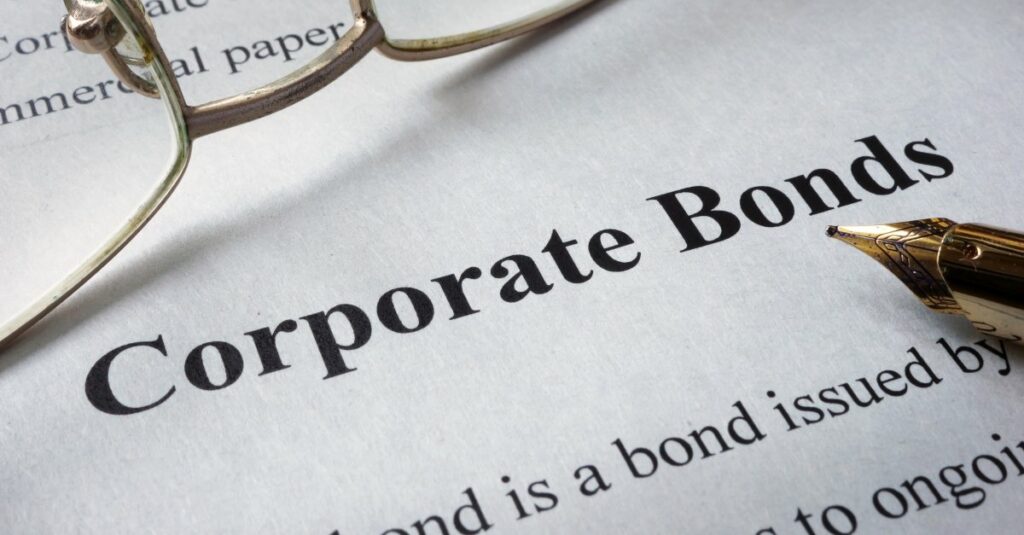What are corporate bonds? Learn about them in this article.
If you are looking to invest as an expat or high-net-worth individual, which is what I specialize in, you can email me (advice@adamfayed.com) or use WhatsApp (+44-7393-450-837).
Table of Contents
Introduction
Bond investing can be a great method to get a return on your money while lowering the chance of suffering a financial loss. This is particularly helpful when you approach a financial objective and during periods of stock market volatility, which can cause significant capital losses quickly.
Corporate bonds frequently offer higher yields than municipal bonds issued by state and local governments and Treasury bonds issued by the federal government.
A company will issue corporate bonds as a way to raise capital. Investors in corporate bonds are lending the firm money, but the corporation is obligated by law to pay the interest stipulated to bondholders.
The corporation pays the bondholder back when a corporate bond matures, which is when the bond’s term expires.
What are Corporate Bonds?
An investor can purchase a corporate bond, a sort of debt product, from a company.
A predetermined number of interest payments at either a fixed or variable interest rate are made to the investor in exchange for the firm receiving the cash it requires. The initial investment is refunded when the bond “reaches maturity,” or expiration.
The ability of the company to repay the debt, which is backed by its potential for future revenues and profitability, serves as the bond’s security in most cases. The tangible property of the business may occasionally be utilized as collateral.
High-quality corporate bonds are viewed as a relatively secure and conservative investment in the investing hierarchy.
Bonds are frequently included in portfolios being built by investors to balance out riskier investments like growth stocks. In order to protect their amassed wealth over their career, these investors typically add more bonds and less riskier investments.
Bonds are a common place for retirees to put a larger amount of their assets in order to create a steady income supplement.
Corporate bonds are typically thought to be riskier than U.S. government bonds. As a result, even for businesses with excellent credit quality, interest rates on corporate bonds are virtually always higher.
The spread between the yields on corporate bonds with excellent ratings and U.S. The credit spread is referred to as Treasuries.
The Difference Between Stocks and Corporate Bonds
When a shareholder purchases a corporate bond, they are making a loan to the business. When an investor purchases stock, they are acquiring ownership in the company.
A stock’s value fluctuates, and the investor’s investment fluctuates along with it. The investor may profit by selling the shares at a higher price, by obtaining dividend payments from the business, or by doing both.
A bond investor receives interest rather than profits from their investment. One crucial distinction is that even a bankrupt corporation must pay its bondholders and other creditors first; otherwise, the original investment cannot be put at risk.
Only until all of those debts have been settled in full may stock owners be compensated for their losses.
In addition, businesses may issue convertible bonds, which, under certain circumstances, may be converted into company shares.

How Corporate Bonds Work
A corporate bond is a loan given to a business for a defined time period with an agreed-upon interest rate. In exchange, the business promises to make interest payments (usually twice a year) and to repay the bond’s face value when it matures.
As an illustration, let’s look at a common fixed-rate bond. If you put $1,000 into a bond with a ten-year maturity and a fixed interest rate of 3%, the corporation will pay you $30 every year and return your $1,000 after ten years.
Although fixed-rate bonds are the most popular, there are additional options to take into account, such as:
- Floating-rate bonds, whose interest rates fluctuate based on benchmarks like the U.S. Treasury yield These are typically issued by organizations that are regarded as trash bonds, or those whose credit ratings are below investment grade.
- Zero-coupon bonds, which do not pay interest. As opposed to paying the full face value, which is the sum the issuer pledges to pay back, you pay less.
- Convertible bonds, which provide businesses the choice to compensate investors when a bond matures with common stock rather than cash.
Types of Corporate Bonds
There are five fundamental categories of corporate bonds: public utilities, transportations, industrials, banks and finance businesses, and overseas offerings.
It is possible to further divide the five groups. Airlines, railroads, and trucking firms are a few examples of the transportation category.
1. Security of Bonds
Security of bonds alludes to an underlying asset of some kind that supports the bond. Investors should choose this since it reduces their risk of a potential business default. Beyond the issuer’s credit, the bond’s supporting assets offer security.
2. Mortgage Bond
Bonds may be backed by a variety of resources. Mortgage-backed securities include, for instance, bonds that are backed by mortgages (MBS). With a mortgage bond, bondholders have the option to recoup any unpaid debt by selling the mortgaged properties.
3. Collateral Trust Bonds
Similar to mortgage bonds, collateral trust bonds do not employ real estate as collateral. Companies that don’t own real estate or fixed assets employ them.
Instead, these businesses hold stock in other businesses. They make their own stocks, bonds, and other investments in other companies as collateral when issuing bonds.
4. Equipment Trust Certificates
Equipment rentals are frequently the focus of equipment trust certificates. Consider, for illustration, that a railway business wants certain cars and purchases them from a supplier. The manufacturer will fulfill the order and give a trustee ownership of the vehicles.
The investors will purchase equipment trust certificates from the trustee after which the automobile manufacturer will be paid. The trustee obtains rental payments from the railway company in order to continue paying interest on the ETCs.
The trustee then transfers the titles to the cars to the railway company following the note’s maturity.
As the railroad business will acquire title to the cars after the conclusion of the ETC agreement, the rental of the railroad cars is not a true leasing arrangement. Consequently, equipment trust certificates are fundamentally a kind of secured debt financing.
5. Debenture Bonds
Bonds known as debenture bonds are unsecured bonds that are not supported by things like specific properties or other assets. Treasury bills are a type of debenture bond that falls under the umbrella of government bonds.
Debenture bonds often have low interest rates because they are typically issued by companies with good credit ratings. Debenture bonds may also be offered by companies that have previously issued mortgage or collateral bonds. In these situations, debenture bonds are issued, and they are thought to be of poorer quality.
6. Convertible Debentures
Debenture bonds may be convertible, meaning that bondholders may choose to convert them into a specific number of shares of the business’s stock at a later date (for example, after two years). Bonds that can be converted typically have lower coupon rates since they are generally more appealing to investors.
7. Guaranteed Bonds
Guaranteed bonds are exactly what their name implies—guaranteed bonds. A different company offers the guarantee.
This lowers the risk of default because another company has committed to assume responsibility for upholding the bond’s covenants in the event that it becomes necessary.
This does not eliminate all default risk from the bond, though, as the company providing the guarantee for the bond could not be able to carry out its end of the guarantee agreement.
8. High Yield Corporate Bonds
The rating of high yield bonds, sometimes known as trash bonds, is below investment grade. The word implies a higher level of risk for the bond, but it does not imply that the firm that issued the bonds would default or face bankruptcy.
Issuers of high yield bonds can be categorized into three groups: initial issuers, fallen angels, restructurings, and leveraged buyouts.
Original issuers are more recent businesses without significant income or balance balances. Bonds are sold with the expectation of future growth and success. Investment-grade enterprises are known as fallen angels.
But as time went on, these businesses encountered problems that caused their credit rating to decline.
Companies have consciously increased their debt loads through restructuring and leveraged buyouts in an effort to boost shareholder value. Due to the companies’ already significant debt loads, the new bonds that these corporations issue are regarded as trash bonds.
How to Sell Corporate Bonds
Blocks of corporate bonds with a face value or par value of $1,000 are issued. The majority of them use a common coupon payment system. To underwrite and market the bond offering to investors, a corporate issuer typically enlists the aid of an investment bank.
Until the bond matures, the issuer sends periodical interest payments to the investor. The bond’s face value is then recovered by the investor. A set interest rate or a rate that fluctuates in accordance with changes in a certain economic indicator may apply to the bonds.
Corporate bonds occasionally include call provisions that permit early prepayment if market interest rates shift so drastically that the issuer decides a new bond would be more advantageous.
Bonds can be sold by investors prior to their maturity. When a bond is sold, its owner receives less money than it is worth. The number of installments left until the bond matures essentially determines how much it is worth.
Investors can also access corporate bonds by purchasing any number of mutual funds or exchange-traded funds (ETFs) that specialize in bonds.

Corporate Bonds: How Are They Distributed?
The corporate trustee is the typical intermediary used to sell corporate bonds. Using a third party to fix some problems is helpful.
For instance, it could be challenging for investors to comprehend covenants and assess whether businesses are abiding by the terms of the contract.
Investors can rely on the trustee to manage the connection with the corporations because they are a knowledgeable third party.
A bank or trust business that authenticates the bonds and keeps track of them when they are sold are examples of corporate trustees. The trustee must take steps to defend the bondholder’s interests if a corporate issuer fails to make interest or principal payments.
However, trustees can only carry out the terms of the contract and are compensated by the debt issuer. Consequently, the trustee may not be able to conduct some investigations into the corporation and frequently must rely on information provided by the corporation.
Why Companies Issue Bonds
Debt financing includes the purchase of corporate bonds. Along with equity, bank loans, and lines of credit, they constitute a significant source of funding for many firms.
They are frequently provided to provide the quick cash needed for a certain project the company wants to take on.
When compared to issuing shares (equity financing), borrowing a company may find it more advantageous to employ debt financing because it often costs less and involves no loss of control or ownership.
To be able to provide debt instruments to the public at an advantageous coupon rate, a corporation typically has to have stable profits potential. A business is able to issue more debt at more affordable rates if its perceived credit quality is higher.
Commercial paper, which is comparable to a bond but normally matures in 270 days or less, may be sold by a company when it needs a relatively short-term cash injection.
Corporate Bond Default Rates
The risk that an issuer won’t pay the principal or the coupon rate is known as the default rate. Divide the total number of issuers at the beginning of the year by the number of issuers who defaulted to arrive at the default rate.
The second method involves dividing the dollar amount of defaulted bonds by the total par value of all existing bonds. Only 640 out of 4,800 corporate issuers, or 0.13%, defaulted on a bond during the 25 years from 1970 to 1994.
It is significant to note that businesses that have missed or delayed payments are also considered to be in default.
Recovery rates must be considered because of how default payment is determined. This is due to the fact that investors frequently get their missed or late payments back. For corporate bonds, the recovery rate is about 38%.
Pained by financial indecision? Want to invest with Adam?

Adam is an internationally recognised author on financial matters, with over 760.2 million answer views on Quora.com, a widely sold book on Amazon, and a contributor on Forbes.



